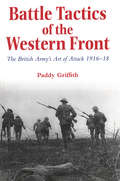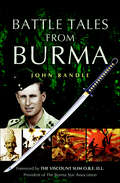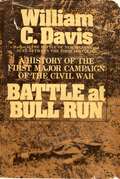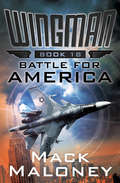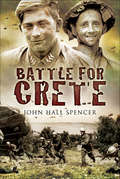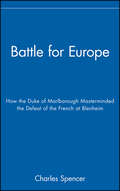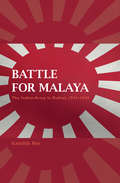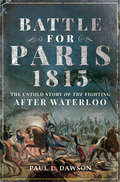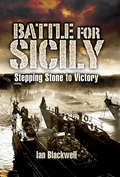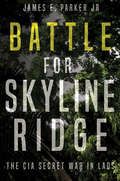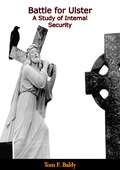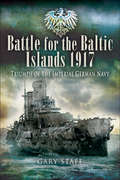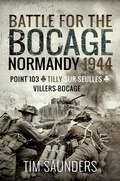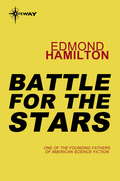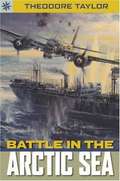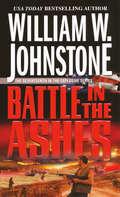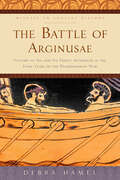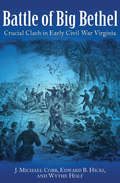- Table View
- List View
Battle Tactics of the Western Front
by Paddy GriffithHistorians have portrayed British participation in World War I as a series of tragic debacles, with lines of men mown down by machine guns, with untried new military technology, and incompetent generals who threw their troops into improvised and unsuccessful attacks. In this book a renowned military historian studies the evolution of British infantry tactics during the war and challenges this interpretation, showing that while the British army's plans and technologies failed persistently during the improvised first half of the war, the army gradually improved its technique, technology, and, eventually, its' self-assurance. By the time of its successful sustained offensive in the fall of 1918, says Paddy Griffith, the British army was demonstrating a battlefield skill and mobility that would rarely be surpassed even during World War II.Evaluating the great gap that exists between theory and practice, between textbook and bullet-swept mudfield, Griffith argues that many battles were carefully planned to exploit advanced tactics and to avoid casualties, but that breakthrough was simply impossible under the conditions of the time. According to Griffith, the British were already masters of "storm troop tactics" by the end of 1916, and in several important respects were further ahead than the Germans would be even in 1918. In fields such as the timing and orchestration of all-arms assaults, predicted artillery fire, "Commando-style" trench raiding, the use of light machine guns, or the barrage fire of heavy machine guns, the British led the world. Although British generals were not military geniuses, says Griffith, they should at least be credited for effectively inventing much of the twentieth-century's art of war.
Battle Tales from Burma
by John RandleA collection of autobiographical stories from an officer in the British Indian Army during World War II. John Randle served with the greatly respected Baluch Regiment of the former Indian Army right through the fiercely fought Burma Campaign, winning a Military Cross, yet on VJ Day he was only some sixty miles from where had started out nearly four years before. Unlike other conventional war memoirs, this book comprises a gratifying number of self-contained stories drawn from the author&’s experiences and memories. Some are long, other mere vignettes; some are moving and serious, others are light-hearted even humorous. Some cover hard-won victories and success, others defeats and reversal; some describe acts of great valor, others incidents reflecting human frailties. All however, are worth reading and give a very accurate picture of war at its bitterest, when men are drawn together and individuals are under that most demanding microscope of their fellow comrades-in-arms.
Battle Yet Unsung: The Fighting Men of the 14th Armored Division in World War II
by Timothy J. O'Keeffe&“An incredible job in shedding light about an often neglected but important role this unit played in the defeat of Nazi Germany&” (WWII History). While headline writers in the European Theater of Operations were naturally focused on events in Normandy and the Bulge in the north, equally ferocious combats were taking place in southern France and Germany during 1944–45, which are now finally getting their due. The US 14th Armored Division—a late arrival to the theater—was thrust into intense combat almost the minute it arrived in Europe, as the Germans remained determined to defend their southern flank. This book explores in detail what happened in the month of January 1945 in the snow-covered Vosges Mountains, when the Wehrmacht&’s attempt to destroy the Sixth Army Group failed. A strategic withdrawal after ten hellish days of fiery combat allowed the Allies to hold the line until a spring offensive. In March, the division literally exploded its way through the Siegfried Line at Steinfeld and began to propel the Wehrmacht into a retreat from which it could never recover. Armored columns kept punching their way through roadblock after roadblock in town after town with powerful artillery and air concentrations that never gave the German soldiers a chance to respond. As a result of the rapid advance of Seventh Army and the 14th, German POW camps like the ones at Hammelburg and Moosburg were liberated of over 100,000 prisoners, an achievement which gave the division the nom de guerre &“The Liberators.&” &“A frontline soldier&’s view of how green troops became battle-wise and battle-weary veterans.&” —The Journal of America&’s Military Past
Battle at Bull Run: A History of the First Major Campaign of the Civil War
by William C. DavisTwo great, untested armies were readying for the first--and what many believed would be the last--major conflict between North and South. On the eve of July 21, 1861, one Northerner wrote: "The sky is perfectly clear, the moon is full and bright, and the air was still as if it were not within a few hours to be disturbed by the roar of cannon and the shouts of contending men." So optimistic were the people in Washington that a crowd of civilians came from the city with picnic hampers to witness the crushing defeat of the upstart "rebels." It was, says William C. Davis, "the twilight of America's innocence," and the following day the mood would shatter in a battle that confounded the expectations of both sides--the first Battle at Bull Run. William C. Davis has written a compelling and complete account of this landmark conflict. The Battle at Bull Run (or Manassas) is notable for many reasons. It was a surprise victory for the Confederacy, a humiliating defeat for the Union, and the first ominous indication that a long and bloody war was inevitable. It marked the first strategic use of railroads in history, and the first time the horrors of the battle were photographed for the folks back home. It was also a training ground for some of America's most colorful military figures: P.G.T. Beauregard, Joe Johnston, Irvin McDowell and "Stonewall" Jackson. Drawing from a wealth of material--old letters, journals, memoirs and military records--Davis brings to life a vivid and vital chapter in American history.
Battle for America (Wingman #18)
by Mack MaloneyAn ace fighter pilot aims to save a shattered America from Russian invasion in this new Wingman novel from &“the best high-action thriller writer out there&” (Jon Land). Former US Air Force major Hawk Hunter and his band of patriotic ex-military men have fought tirelessly to reunite their fractured nation after the Russian nuclear sneak attack that put a devastating end to World War III. Now, returning from a space odyssey that began with the diversion of a comet headed for Earth, Hunter finds a 60,000-man Russian army occupying New York City, ready to invade the rest of America. Equally alarming are reports claiming that Hawk&’s former girlfriend, Dominique, is living with the head of the Russian secret police in a Manhattan penthouse. Buzzing through the city&’s skyscraper canyons in a tiny STOL Highlander and glimpsing the enemy invaders&’ massive weaponry for himself, Hawk realizes he&’s up against the greatest danger his homeland has ever faced, even with the help of Captain &“Bull&” Dozer and his team of ex-Marines. But with the woman and the country he loves in dire peril, threatened by a mysterious convoy of Russian superships, the Wingman will apply all his aviation prowess and strategic ingenuity to devise a plan to launch the fiercest, most crucial battle for America yet, no matter the risks. Filled with fast-paced, furious action and a wide range of aircraft and military hardware that will fascinate techno-thriller fans, Battle for America brings back favorite characters from earlier books in the series and delivers a riveting story that reveals new insight on America&’s most enigmatic hero: the Wingman.
Battle for Crete
by John Hall SpencerThis WW2 military history “combin[es] a look at the background to the battle . . . and the ground level memories of the participants with great skill.” (History of War.org)After two years’ extensive research, John Hall Spencer has written a thorough account of the political and military background to the German invasion of Crete and the bitter fighting that followed the first airborne assault on an island in history. Battle for Crete tells of confused negotiations between the British and Greek governments; the misunderstandings between Winston Churchill’s War Cabinet and commanders in the field; the near capture of the King of Greece; the lack of preparation by the defenders and the suppression of a critical post-battle report by General Wavell.There are vivid eyewitness accounts of the fighting both during the invasion and the subsequent campaign and ultimate retreat and evacuation. The Royal Navy and Royal Air Force’s contribution is well documented, as are the roles of the German air force, in this “close run” campaign fought with aggression by both sides.
Battle for Europe: How the Duke of Marlborough Masterminded the Defeat of the French at Blenheim
by Charles SpencerA &“wondrously enthralling&” history of the bloody battle that ended Louis XIV&’s dream of European domination (The Times, UK). In 1704, the armies of French King Louis XIV were poised to extend the French frontiers to the Rhine and install a French prince on the Spanish throne. But as French forces marched toward Vienna, allied armies commanded by John Churchill, Duke of Marlborough, and Prince Eugene of Savoy set out to oppose them. The two forces clashed at Blenheim, in Bavaria, and the previously undefeated French were routed. Based on original sources, this &“thoughtful, interesting, and well-written&” narrative brings the battle to life, capturing the deliberations of kings as well as the experiences of ordinary soldiers (The Sunday Telegraph, UK).
Battle for Malaya: The Indian Army in Defeat, 1941–1942 (Twentieth-century Battles Ser.)
by Kaushik RoyThe historian and author of The Army in British India analyzes the British Indian Army’s devastating loss to the Imperial Japanese during WWII.The defeat of 90,000 Commonwealth soldiers by 50,000 Japanese soldiers made the World War II Battle for Malaya an important encounter for both political and military reasons. British military prestige was shattered, fanning the fires of nationalism in Asia, especially in India. Japan’s successful tactics in Malaya—rapid marches, wide outflanking movement along difficult terrain, nocturnal attacks, and roadblocks—would be repeated in Burma in 1942–43. Until the Allied command evolved adequate countermeasures, Japanese soldiers remained supreme in the field. Looking beyond the failures of command, Kaushik Roy focuses on tactics of the ground battle that unfolded in Malaya between December 1941 and February 1942. His analysis includes the organization of the Indian Army—the largest portion of Commonwealth troops—and compares it to the British and Australian armies that fought side by side with Indian soldiers. Utilizing both official war office records and personal memoirs, autobiographies, and oral histories, Roy presents a comprehensive narrative of operations interwoven with tactical analysis of the Battle for Malaya.
Battle for Malaya: The Indian Army in Defeat, 1941–1942 (Twentieth-century Battles Ser.)
by Kaushik RoyThe historian and author of The Army in British India analyzes the British Indian Army’s devastating loss to the Imperial Japanese during WWII.The defeat of 90,000 Commonwealth soldiers by 50,000 Japanese soldiers made the World War II Battle for Malaya an important encounter for both political and military reasons. British military prestige was shattered, fanning the fires of nationalism in Asia, especially in India. Japan’s successful tactics in Malaya—rapid marches, wide outflanking movement along difficult terrain, nocturnal attacks, and roadblocks—would be repeated in Burma in 1942–43. Until the Allied command evolved adequate countermeasures, Japanese soldiers remained supreme in the field. Looking beyond the failures of command, Kaushik Roy focuses on tactics of the ground battle that unfolded in Malaya between December 1941 and February 1942. His analysis includes the organization of the Indian Army—the largest portion of Commonwealth troops—and compares it to the British and Australian armies that fought side by side with Indian soldiers. Utilizing both official war office records and personal memoirs, autobiographies, and oral histories, Roy presents a comprehensive narrative of operations interwoven with tactical analysis of the Battle for Malaya.
Battle for Manhattan
by Bruce Bliven Jr.First published in 1956, this book by ex-WWII lieutenant Bruce Bliven, Jr. tells the story of the three-day battle of Manhattan, New York in September 1776, which saw George Washington preserving his army during a long retreat from the British troops.At the time of its first release, the book drew praise for using present-day names for locations to put historic events in perspective, a technique the author referred to as “terrain appreciation,” rounding out the book with authenticated descriptions of New York in 1776 that will leave the reader captivated.“Bliven’s book—a virtually perfect example of the military monograph—consistently reminds readers that these are not distant and alien battlefields he’s talking about; indeed, this is ground thousands of New Yorkers now commute across without a second thought…”—Steve Donoghue, Stevereads
Battle for Paris 1815: The Untold Story of the Fighting After Waterloo
by Paul L. Dawson&“For anyone seeking a full understanding of the end of the Napoleonic era this book is a must read . . . [a] tour de force of research.&” —Clash of Steel On the morning of 3 July 1815, the French General Rémi Joseph Isidore Exelmans, at the head of a brigade of dragoons, fired the last shots in the defense of Paris until the Franco-Prussian War sixty-five years later. Why did he do so? Traditional stories of 1815 end with Waterloo, that fateful day of 18 June, when Napoleon Bonaparte fought and lost his last battle, abdicating his throne on 22 June. But Waterloo was not the end; it was the beginning of a new and untold story. Seldom studied in French histories and virtually ignored by English writers, the French Army fought on after Waterloo. Many commanders sought to reverse that defeat—at Versailles, Sevres, Rocquencourt, and La Souffel, the last great battle and the last French victory of the Napoleonic Wars. Marshal Grouchy, much maligned, fought his army back to Paris by 29 June, with the Prussians hard on his heels. On 1 July, Vandamme, Exelmans and Marshal Davout began the defense of Paris. Davout took to the field in the north-eastern suburbs of Paris along with regiments of the Imperial Guard and battalions of National Guards. For the first time ever, using the wealth of material held in the French Army archives in Paris, along with eyewitness testimonies from those who were there, Paul Dawson brings alive the bitter and desperate fighting in defense of the French capital. The 100 Days Campaign did not end at Waterloo, it ended under the walls of Paris fifteen days later.
Battle for Paris 1815: The Untold Story of the Fighting After Waterloo
by Paul L. Dawson&“For anyone seeking a full understanding of the end of the Napoleonic era this book is a must read . . . [a] tour de force of research.&” —Clash of Steel On the morning of 3 July 1815, the French General Rémi Joseph Isidore Exelmans, at the head of a brigade of dragoons, fired the last shots in the defense of Paris until the Franco-Prussian War sixty-five years later. Why did he do so? Traditional stories of 1815 end with Waterloo, that fateful day of 18 June, when Napoleon Bonaparte fought and lost his last battle, abdicating his throne on 22 June. But Waterloo was not the end; it was the beginning of a new and untold story. Seldom studied in French histories and virtually ignored by English writers, the French Army fought on after Waterloo. Many commanders sought to reverse that defeat—at Versailles, Sevres, Rocquencourt, and La Souffel, the last great battle and the last French victory of the Napoleonic Wars. Marshal Grouchy, much maligned, fought his army back to Paris by 29 June, with the Prussians hard on his heels. On 1 July, Vandamme, Exelmans and Marshal Davout began the defense of Paris. Davout took to the field in the north-eastern suburbs of Paris along with regiments of the Imperial Guard and battalions of National Guards. For the first time ever, using the wealth of material held in the French Army archives in Paris, along with eyewitness testimonies from those who were there, Paul Dawson brings alive the bitter and desperate fighting in defense of the French capital. The 100 Days Campaign did not end at Waterloo, it ended under the walls of Paris fifteen days later.
Battle for Sicily: Stepping Stone to Victory
by Ian BlackwellOn the night of 9-10 July 1943, an Allied armada launched the invasion of Sicily, a larger operation than the Normandy landings the following year. Over the next thirty-eight days, half a million Allied servicemen fought the Germans and Italians for control of this rocky island, which was to become the first part of Axis homeland to fall during World War II.Despite their success in capturing the island, inter-Allied and inter-service divisions and rivalries robbed them of the opportunity to inflict a crushing defeat on the Germans and Italians, who were able to conduct a fighting withdrawal to the Italian mainland and save sizable forces to continue the war. Regarded by some as a "blind alley" and by others as the way into Europe via the "soft underbelly", the decision to invade Sicily was and remains controversial. Notwithstanding the campaigns failure to achieve its potential, invaluable lessons were learned which contributed to success in France later. Many of the leading generals who were to take prominent roles in northwest Europe amongst them Eisenhower, Montgomery, Bradley and Patton brought with them the experience of Sicily.
Battle for Skyline Ridge: The CIA Secret War in Laos
by James E. Parker Jr.&“An incredibly powerful account of a little-known chapter in the Vietnam War saga&” written by a CIA veteran who fought in the Secret War (Booklist, starred review). In the 1960s and &’70s, the Laotian Civil War became a covert theater for the conflict in Vietnam, with the US paramilitary backing the Royal Lao government in what came to be known among the CIA as the Secret War. In late 1971, the North Vietnamese Army launched Campaign Z, invading northern Laos on a mission to defeat the Royal Lao Army. General Giap had specifically ordered the NVA troops to kill the CIA army and occupy its field headquarters in the Long Tieng valley. The NVA faced the small rag-tag army of Vang Pao, mostly Thai irregulars recruited to fight for the CIA. But thousands more were quickly recruited, trained, and rushed into position in Laos to defend against the impending NVA invasion. Despite overwhelming odds in the NVA&’s favor, the battle raged for more than one hundred days—the longest battle in the Vietnam War. In the end, it all came down to Skyline Ridge. Whoever won Skyline, won Laos. Historian James E. Parker Jr. served as a CIA paramilitary officer in Laos. In this authoritative and personal account, Parker draws from his own firsthand experience as well as extensive research into CIA files and North Vietnamese after-action reports in order to tell the full story of the battle of Skyline Ridge.
Battle for Ulster: A Study of Internal Security
by Tom F. BaldyAttention to the conflict in Northern Ireland is often pre-empted in North America by such other international problems as worldwide terrorism, eruptions in the Middle East, and insurgencies in Latin America. The Irish “troubles” seem to catch our attention primarily as headline events, such as the 1981 hunger strikes or the 1983 Christmas bombing of Harrod’s department store. Yet the protracted violence in Northern Ireland doesn’t cease between spectacular and heavily reported incidents—the violence continues daily. Indeed, since 1969, terrorist violence has killed more than 2,500 people and injured another 29,000.As Tom F, Baldy points out in this study, the British government’s internal security operation has sought for years to control the violence in Northern Ireland. To explain the existing situation, Mr. Baldy reviews the historical roots of the conflict, identifies its major factions, and outlines various options for its resolution. Baldy contends the British have managed, with their internal security operation, to limit open violence, but have failed to attain the ultimate objective: a workable, mutually acceptable political solution. Keeping that British goal in mind, Baldy speculates on Northern Ireland’s future.The “troubles” in Northern Ireland pose a continuing challenge to one of the United States’ most reliable and closest allies. The unique local issues aside, Britain’s effort to resolve the conflict within the United Kingdom nevertheless provides insights for people and governments confronting terrorism and guerrilla warfare in many other areas of the world, and reminds all of the dangers of factionalism for free governments.
Battle for the Baltic Islands, 1917: Triumph of the Imperial German Navy
by Gary Staff&“A very detailed operational account of the highly successful German amphibious landings in October of 1917 on the Russian islands of Osel and Dago.&”—The NYMAS Review In late 1917, the Russians, despite the revolution, were still willing to continue the war against Germany. This is an account of Operation Albion, the highly successful seaborne operation launched by the Germans to change their minds. The Baltic Islands were pivotal for the defense of the Finnish Gulf and St. Petersburg, so their capture was essential for any campaign towards the Russian capital. Only after the fall of the islands did Russia begin peace negotiations (freeing nearly half a million German soldiers for the Kaiser&’s last gamble on the Western Front). This then was a campaign of great significance for the war on both Eastern and Western fronts. A large part of the High Sea Fleet took part in the invasion of the Baltic islands, including the most modern dreadnought battleships. The Russians mounted a resolute defense despite being heavily outgunned and over a ten-day period there were many naval clashes around the islands as well as the campaign ashore, all of which are described in detail with the use of both Russian and German firsthand accounts. This book shatters the myth that the Imperial German Navy spent the last two years of the war cowering in port. &“Should be a blueprint for other military history books . . . The maps are some of the best I have seen in military books . . . The author tells the story of the campaign from the smallest mine sweeper to the various battleships involved.&”—A Wargamers Needful Things
Battle for the Bocage: The Fight for Point 103, Tilly-sur-Seulles, Vilers Bocage (Battleground Normandy Ser.)
by Tim SaundersThis WWII military study examines the combat experiences of three Allied divisions charged with spearheading the invasion of Normandy. To lead the charge into France after the Normandy landings, General Montgomery brought three veteran desert formations back from the Mediterranean. They were the 50th Infantry and 7th Armored divisions, plus 4th Armored Brigade. Their task beyond the beaches was to push south to Villers Bocage with armor on the evening of D-Day in order to disrupt German counter-attacks on the beachhead. Difficulties on 50th Division&’s beaches allowed time for German reinforcements to arrive in Normandy. As a result, 4th Armored Brigade was firmly blocked just south of Point 103 after an advance of less than five miles. A major counter-attack by Panzer Lehr failed, as did a renewed British attempt, this time by the vaunted 7th Armored Division, which was halted at Tilly sur Seulles. From here the fighting became a progressively attritional struggle in the hedgerows of the Bocage country south of Bayeux. More units were drawn into the fighting, which steadily extended west. Finally, an opportunity to outflank the German defenses via the Caumont Gap allowed 7th Armored Division to reach Villers Bocage. There then followed what the battalions of 50th Division describe as their &‘most unpleasant period of the war&’, in bitter fighting, at often very close quarters, for the &‘next hedgerow&’.
Battle for the Escaut, 1940: The France and Flanders Campaign
by Jerry MurlandOn 10 May 1940 the British Expeditionary Force (BEF), under the command of Lord Gort, moved forward from the Franco-Belgian border and took up positions along a 20-mile sector off the River Dyle, to await the arrival of the German Army Group B. Their expected stay was considerably shorter than planned as the German Army Group A pushed its way through the Ardennes and crossed the Meuse at Sedan, scattering the French before them. Little did the men of the BEF realise that the orders to retire would result in their evacuation from Dunkirk and other channel ports.The line of the River Escaut was seen as the last real opportunity for the Allied armies to halt the advancing German Army, but the jigsaw of defence was tenuous and the allied hold on the river was undone by the weight of opposing German forces and the speed of the armoured Blitzkrieg thrust further south. As far as the BEF were concerned, the Battle for the Escaut took place on a 30-mile sector from Oudenaarde to Blharies and involved units in a sometimes desperate defence, during which two Victoria Crosses were awarded. This book takes the battlefield tourist from Oudenaarde to Hollain in a series of tours that retrace the footsteps of the BEF. With the help of local historians, the author has pinpointed crucial actions and answered some of the myriad questions associated with this important phase of the France and Flanders campaign of 1940.
Battle for the Stars
by Edmond HamiltonIt was no place for man to be. Men were tissue, blood, bone, nerve. This place was not made for them. It was made for force and radiation. Go home, men.But I can't, thought Jay Birrel. Not yet...I have to go on into this place where a human being looks as pathetic as an insect in a furnace.
Battle for the Ukraine: The Korsun'-Shevchenkovskii Operation (Soviet (Russian) Study of War)
by Harold S. Orenstein David M. GlantzA comprehensive guide to the battle for the Ukraine from the Soviet perspective during the winter of 1943-1944. This volume is an unexpurgated translation of the originally classified Soviet General Staff Study No.14.
Battle in the Arctic Sea
by Theodore TaylorAmerica's most crucial mission was to provide arms and supplies to our English and Russian allies. Taylor, who served in the merchant marines in World War II, tells the tragic tale of a convoy of 33 ships that sailed from Iceland to Russia.
Battle in the Ashes (Ashes #17)
by William W. JohnstoneA resurgent America faces a terrifying horde of post-apocalyptic Nazis in the New York Times–bestselling author&’s dystopian military thriller. Chilling rumors of a new Nazi movement reach the rebel camp of Ben Raines and his freedom fighters. Led by descendants of Hitler's Third Reich, Commanding General Jesus Mendoza Hoffman has assembled a massive army in the mountains of South America. Estimated at more than 200,000 strong, Hoffman and his New Army of Liberation terrorists will stop at nothing to spread their doctrine of evil across the free world. Striking northward, Hoffman&’s invaders march into Mexico, where the Mexican army is no match for them. Now, as the doomsday forces turn Texas into a beleaguered battleground, Raines and his troops must fight to prevent America from erupting in a holocaustic bloodbath of atrocity and death. Seventeenth in the long-running series!
Battle in the Baltic: The Royal Navy and the Fight to Save Estonia & Latvia, 1918–1920
by Steve R Dunn Al RossThe little-known campaign to save Latvian and Estonian independence: "Anyone interested in naval operations is likely to find some useful food for thought.” —StrategyPageFor most participants, the First World War ended on November 11, 1918. But Britain’s Royal Navy found itself, after four years of slaughter and war weariness, fighting a fierce and brutal battle in the Baltic Sea against Bolshevik Russia in an attempt to protect the fragile independence of the newly liberated states of Estonia and Latvia.This book describes the events of those two years when Royal Navy ships and men, under the command of Rear Admiral Walter Cowan, found themselves in a maelstrom of chaos and conflicting loyalties, and facing multiple opponents—the communist forces of the Red Army and Navy, led by Leon Trotsky; the gangs of freebooting German soldiers, the Freikorps, intent on keeping the Baltic states under German domination; and the White Russian forces, bent on retaking Petrograd and rebuilding the Russian Empire. During this hard-fought campaign there were successes on both sides. For example, the Royal Navy captured two destroyers that were given to the Estonians; but the submarine L-55 was sunk by Russian warships, lost with all hands. Seeking revenge in a daring sequence of attacks and using small coastal motor boats, the RN sank the cruiser Oleg and badly damaged two Russian battleships.Today few people are aware of this exhausting campaign and the sacrifices made by Royal Navy sailors, but this book retells their exciting but forgotten stories and, using much firsthand testimony, bring back to life the critical naval operations that prevented the retaking of the new Baltic countries that Churchill saw as an essential shield against the encroachment of the Bolsheviks into Europe—and resulted in an uneasy peace that would prevail until 1939.
Battle of Arginusae: Victory at Sea and Its Tragic Aftermath in the Final Years of the Peloponnesian War (Witness to Ancient History)
by Debra HamelAn Athenian triumph against Sparta end in disaster and infamy in this naval history of Ancient Greece in the 5th century B.C.Toward the end of the Peloponnesian War, nearly three hundred Athenian and Spartan ships fought a pivotal skirmish in the Arginusae Islands. Larger than any previous naval battle between warring Greeks, the Battle of Arginusae was a crucial win for Athens. Its aftermath, however, was a major disaster for its people.Due to numerous factors, the Athenian commanders abandoned the crews of twenty-five disabled ships. Thousands of soldiers were left clinging to wreckage and awaiting help that never came. When the failure was discovered back home, the eight generals in charge were deposed. Two fled into exile, while the other six were tried and executed.In The Battle of Arginusae, historian Debra Hamel describes the violent battle and its horrible aftermath. Hamel introduces readers to Athens and Sparta, the two thriving superpowers of the fifth century B.C. She provides a summary of the events that caused the long war and discusses the tactical intricacies of Greek naval warfare. Recreating the claustrophobic, unhygienic conditions in which the ships’ crews operated, Hamel unfolds the process that turned this naval victory into one of the most infamous chapters in the city-state’s history.
Battle of Big Bethel: Crucial Clash in Early Civil War Virginia
by J. Michael Cobb Edward B. Hicks Wythe HoltThe Battle of Big Bethel: Crucial Clash in Early Civil War Virginia by J. Michael Cobb, Ed Hicks, and Wythe Holt is the first full-length treatment of the small but consequential June 1861 battle that reshaped both Northern and Southern perceptions about what lay in store for the divided nation. In the spring of 1861, many people in the North and South imagined that the Civil War would be short and nearly bloodless. The first planned engagement of the war at Big Bethel, however, provided undeniable evidence of just how wrong popular opinion could be.Major General Benjamin F. Butler was in command of Union forces at Fort Monroe, Virginia, at the tip of the peninsula between the James and York rivers only ninety miles from the Confederate capital at Richmond. Thanks to the foresight of Lt. Gen. Winfield Scott, President Abraham Lincolns elderly chief military adviser, thousands of troops had been assigned to Butler to protect the fort, eventually threaten Richmond, and perhaps bring a quick end to the war.Opposing the Yankees was the aggressive and dramatic Col. John Bankhead Magruder, who decided to lure Butler into a fight. Magruder fortified a strategic swampy creek crossing, skillfully placed several artillery pieces, selected excellent defensive positions for his 1,500 men, and camouflaged the whole with brush. Never one to shy away from a challenge, Butler marshaled about 4,000 men for a daring dawn attack.Although Butler launched three charges against earthworks well supported by artillery, each was repulsed. Several reasons account for this, including friendly-fire, a combination of murderous cannon and musketry, Magruders deft handling of his men, the inexperience of the attackers, and poor Union leadership. One of the sterling performances of the day was turned in by Col. Daniel H. Hill, who ordered his Southern infantry to move across the enemys front to retake a forward redoubt.Although the carnage was light compared to later battles, the combat at Big Bethel remained indelibly imprinted on those who fought there. The successful defense reinforced the belief most Southerners held that their martial invincibility and defense of home and hearth were divinely inspired. After initial disbelief and shame, the defeat hardened Northern resolution to preserve their sacred Union. The notion began to take hold that, contrary to popular belief, the war would be difficult and protracteda belief that was cemented in reality the following month on the plains of Manassas.Years in the making, The Battle of Big Bethel relies upon letters, diaries, newspapers, reminiscences, official records, and period imagessome used for the first time. The authors detail the events leading up to the encounter, survey the personalities as well as the contributions of the participants, set forth a nuanced description of the confusion-ridden field of battle, and elaborate upon its consequences. Here, finally, the story of Big Bethel is colorfully and compellingly brought to life through the words and deeds of a fascinating array of soldiers, civilians, contraband slaves, and politicians whose lives intersected on that fateful day in the early summer of 1861.
